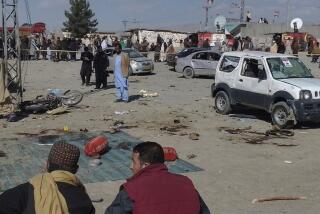U.S. and Afghan Forces Kill 25 Suspected Taliban in Two Raids
- Share via
KABUL, Afghanistan — U.S. and Afghan forces killed 25 suspected Taliban fighters and captured dozens more in operations in two southern provinces over two days, Afghan and U.S. officials said.
On Monday, U.S. and Afghan forces killed 12 suspected militants and detained nine others in a raid in Zabol province, the U.S. military said. Soldiers were brought by helicopter into a remote area where militants were believed to be gathering before launching attacks. No casualties were reported among the Afghan and U.S. forces.
The operation in Zabol followed a raid in neighboring Kandahar province in which U.S. and Afghan forces killed 13 suspected Taliban fighters, and captured dozens more, in a remote area where a political candidate was kidnapped and executed last week, a provincial official said.
U.S. and Afghan troops dropped by parachute from American aircraft in the operation, which began Sunday, Kandahar Gov. Asadullah Khalid said by telephone from Kandahar city, the provincial capital. None of the coalition troops was injured.
The assault targeted insurgents suspected of killing Khan Mohammed, a candidate for Kandahar’s provincial council in the country’s Sept. 18 election who was abducted Friday, the governor added. A district commissioner and three policemen were killed along with Mohammed.
At least four other candidates have been killed in the weeks before the election for the lower house of Afghanistan’s parliament and provincial councils. It is Afghanistan’s first parliamentary election since U.S.-led forces toppled the Taliban’s hard-line Islamic regime in late 2001.
Backed by U.S. attack helicopters, the American and Afghan troops, and local police, landed Sunday in the Lal valley, about 50 miles northwest of Kandahar, the governor said. More than 40 suspected insurgents were detained. They are being interrogated, U.S. Col. Jim Yonts, spokesman for the coalition forces, told reporters in Kabul, the Afghan capital.
Khalid said some of them might be released soon, while the rest would be put on trial as Taliban militants.
“I think this was a group that was hiding and getting ready to conduct operations to bring chaos to the process of the elections in Afghanistan, so this [assault] will decrease the danger of the Taliban insurgency,” the governor added.
Yonts denied there was any link between the offensive, which was still underway Monday, and Friday’s kidnappings and executions.
“What you have here is when coalition forces are notified, through intelligence means, that there are enemy forces in an area, we will quickly and aggressively take the fight to them,” Yonts said.
Taliban and allied guerrillas have killed at least 51 U.S. troops in Afghanistan this year, the heaviest combat losses for American forces since the war against the Taliban and its allies in the Al Qaeda terrorist network began in 2001. More than 1,000 Afghans, many of them civilian victims of insurgent attacks, have died.
But the international security force led by the North Atlantic Treaty Organization in the country considers the militants’ attack rate similar to that for the period before last year’s presidential election, said Maj. Andrew Elmes, a British spokesman.
Millions of Afghans defied Taliban threats and turned out to vote in an election won by President Hamid Karzai, a strong U.S. ally.
United Nations organizers say that with more than 5,800 candidates from 72 parties running in the upcoming election, their task is several times more complicated than last year’s vote.
In other recent attacks in southern Afghanistan, insurgents killed five Afghan police officers in an ambush Sunday. The previous day, guerrillas killed three Afghan police officers guarding a supply convoy headed to a U.S. military base.
Despite daily attacks by guerrillas across large swaths of southern and eastern Afghanistan, Yonts said the U.S. military saw the attacks as local or regional operations without any national coordination.
“In our assessment, it is not connected to any kind of a network,” he said. “You will see an individual attack here, you may see an individual attack in this [other] province over here. But there is nothing that we see that fuses that together from any sort of an infrastructure, or coordinated program.”
The insurgents mainly operate in cells of one to five fighters, Yonts said.
More to Read
Sign up for Essential California
The most important California stories and recommendations in your inbox every morning.
You may occasionally receive promotional content from the Los Angeles Times.












